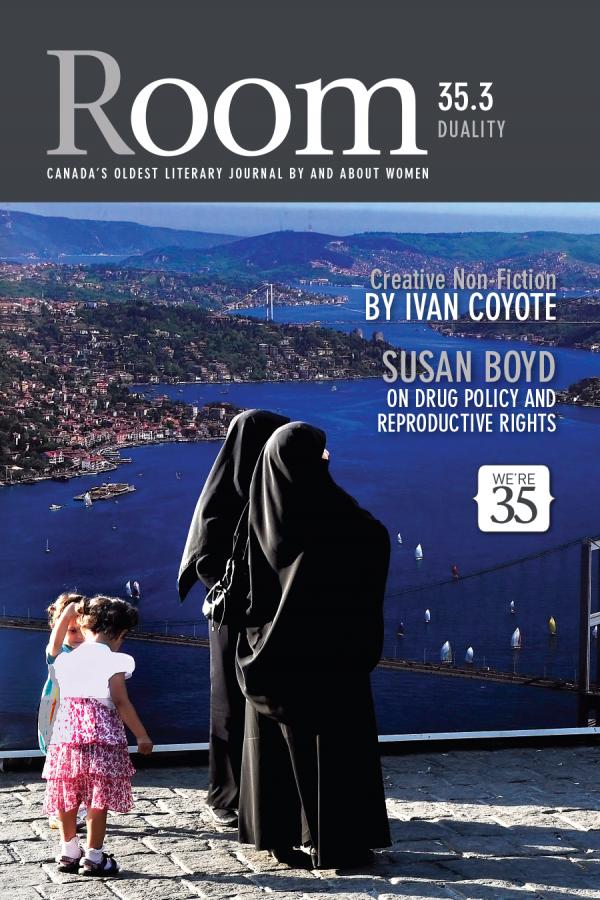Duality | 35.3
2012
Digital only; out of stock in print.
The theme for this third issue in our thirty-fifth anniversary volume was inspired by Paddy Chitty’s poem “Diptych.”
The theme for this third issue in our thirty-fifth anniversary volume was inspired by Paddy Chitty’s poem “Diptych.” It got us thinking about this notion of themed pairs: extrapolated, how one thing can exist only in the presence or absence of something else, sometimes in contrasts. These dualities exist in women’s lives in both dramatic and nuanced ways. As you delve into the pages of this issue, consider the darkness that lurks beneath the surface of the fierce images and the references to “sin and shame” in Danielle Boodoo-Fortuné’s poetry. Silence and voice are explored in Joanna Kurowska’s poetry, while voice is found through translation in the “Translations of Babel” poems by Rita D. Costello, and through female sexuality in Coleena Fanjoy’s “She.”
A woman’s life experience most certainly contains moments of invisibility. Sarah Bernstein’s short story creates a surreal, dream-like state that mesmerizes the reader through to the pivotal transformation. The narrator’s muse in Elizabeth Withey’s “pink parka” is both visible and invisible, her obvious unwell state ignored while the shopping bags of her fellow bus passengers “slop into the aisle.” Susan Maeder’s Joan of Arc in “Out of Blue” is discouraged from being so visible: the battlefield is no place for a woman.
Sex doesn’t go unnoticed in our issue. Literary inferences describe the experience of being “a smudge between transcripts”—desired, then dismissed—in Chantelle Rideout’s poem “Imprint,” while Dimitra Xidous’s “Here is a box” is a provocative metaphor, rhythmic, teetering until the final stanza. Other pieces will linger with you. Feel the desire, smell the heady fragrances, and taste the pomegranate and the certainty of the end in Mary Ann Moore’s “Walking on Water.” Unfulfilled desire is also evident in Barbara Lorraine Laing’s poem “The Muse.”
A number of the pieces selected for this issue demonstrate the tensions created by the passage of time. The protagonist in Eliza Robertson’s story “Good for the Bones” lives in an uncertain psychological place, between past and present. Michelle Barker’s poetry confirms the past’s necessary intrusion into the present, as well as the dissonance between safety and adventure. Fanjoy’s poem “Ink” also seeks excitement, while clinging to nostalgia. The recognition of that which is and that which we imagined would be is hinted at in Kurowska’s sinister “The Woman With a Spider,” a dovetailing of abuse and love. It’s also brought to light in the journey to motherhood in Clea Robert’s rich poem “Letter to my daughter,” while a journey away from innocence is just beginning in Yvonne Blomer’s “Toddling, after Persephone.”
The profound emotions that accompany the dichotomies of life and death are shared with good humour from our commissioned author and storyteller Ivan Coyote in “Kraft Singles for Everyone.” Loss and new beginnings are also beautifully portrayed in Blomer’s poem “This is for the people who disappear,” whereas the widowed narrator in Martha Amore’s story “Freeze-up” numbly wonders about the impact of her profound sadness on her ability to give love to her young daughter. Dawn Lwakila illustrates a child’s grieving as she attempts to make sense of the greys between ‘right’ and ‘wrong’ in the case of murder in “The Way Out.”
Our interview with Professor Susan Boyd engages in a thoughtful dialogue about societal perceptions that contribute to policies regulating maternal drug use. Joan Baril’s creative non-fiction piece further illustrates government-sanctioned discrimination and racialization. Written from the perspective of Anishinabe child Ma-nee Chacaby, “The Scoop, 1955” narrates a loss of epic proportions as it recollects the Canadian government’s sanctioned removal of some 150,000 Aboriginal children from their homes to residential schools. In Elizabeth Derksen’s poem “Ossis,” self-examination demonstrates how we are all separate yet connected.
Our provocative cover photograph was taken by Nursen Seval in Istanbul, and has generated a lot of political, religious, and gendered discussions among photographers on the fotokritik website. We are also pleased to showcase Sarah Clement, whose work plays well on dualities.
We hope that this issue, the third volume in our anniversary year, will challenge us all to look at the nuances within ourselves, our experiences, our relationships, and the political world in which we live. And in so doing—to reference the late, great Audre Lorde—transform our silence.
We are pleased to invite you to attend the launch event for Room 35.3: Duality on the evening of October 18th at 7pm at the W2 Media Café. More information can be found here.

$10.00
Additional information
| Delivery | Canada, USA, International, Digital |
|---|
In this issue: Martha Amore, Joan Baril, Michelle Barker, Sarah Bernstein, Yvonne Blomer, Danielle Boodoo-Fortuné, Paddy Chitty, Sarah Clement, Rita D. Costello, Ivan E. Coyote, Elizabeth Derksen, Coleena Fanjoy, Candace Fertile, Amber Hitchen, Joanna Kurowska, Barbara Lorraine Laing, Dawn Lwakila, Susan Maeder, Mary Ann Moore, Helen Polychronakos, Chantelle Rideout, Clea Roberts, Eliza Robertson, Nursen Seval, Jean Van Loon, Elizabeth Withey, Dimitra Xidous